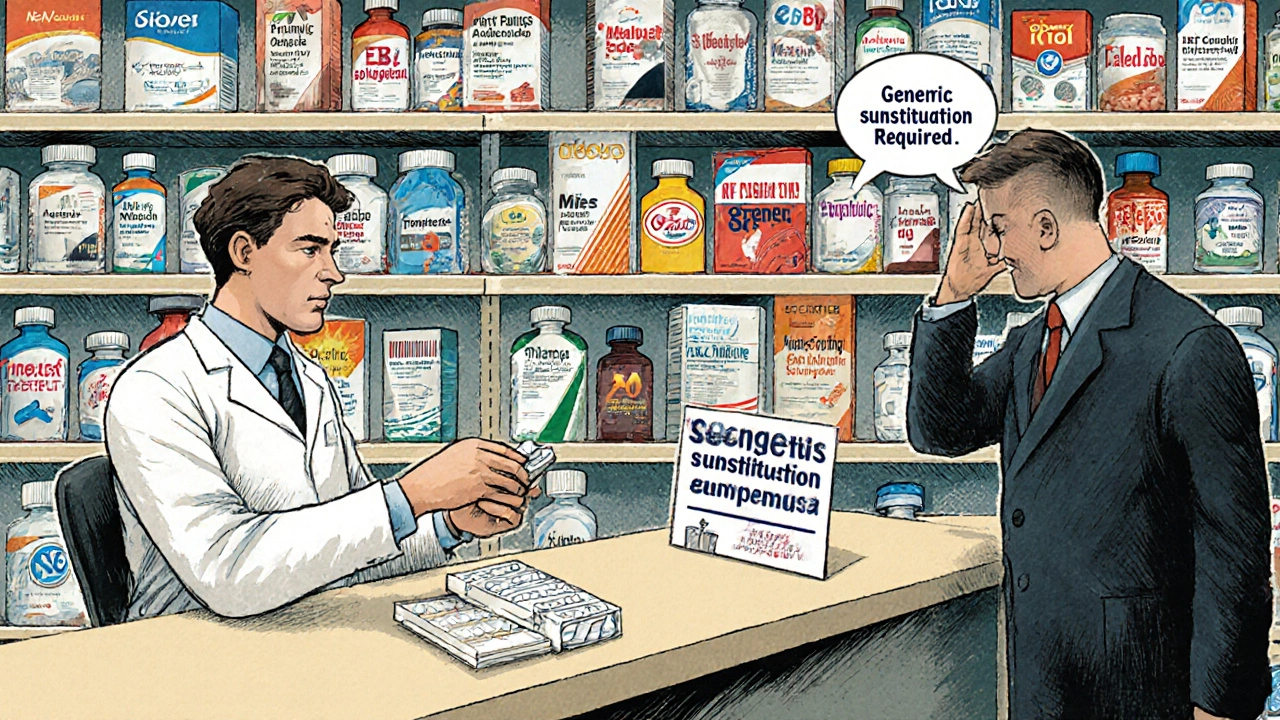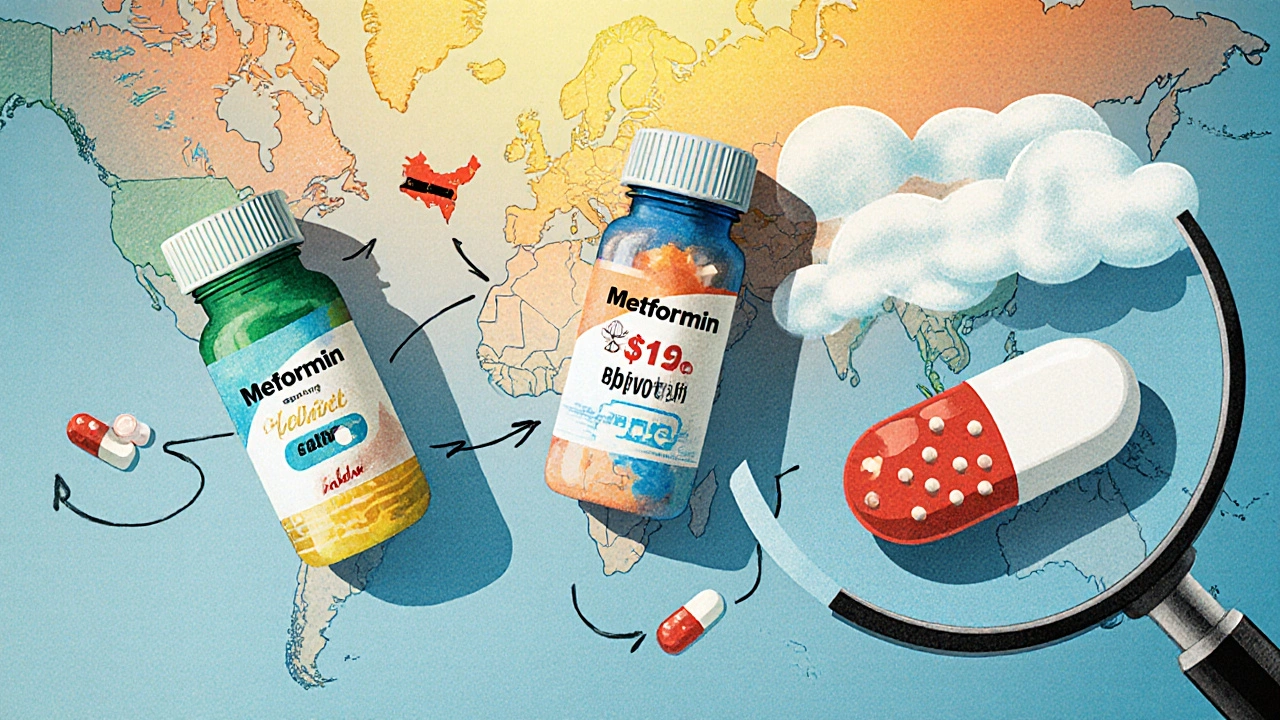Ever wonder why your prescription for metformin costs $4 in India, $12 in Germany, and $45 in the U.S.-even though it’s the exact same pill? It’s not a trick. It’s the reality of how generic drugs work across the globe. Generic medications contain the same active ingredients as brand-name drugs, but they’re sold after patents expire. They’re supposed to be cheaper, safer, and just as effective. But in practice, their availability, price, and even quality vary wildly from country to country.
How Much of Your Prescription Is Actually Generic?
In the United Kingdom, about 83% of all prescriptions are filled with generic drugs. In Germany, it’s 80%. In the Netherlands, it’s 70%. These countries have policies that push pharmacists to substitute brand-name drugs with generics unless the doctor specifically says no. That’s not the case everywhere. In Switzerland, only 17% of prescriptions are for generics. In Italy and Greece, it’s around 20%. Why? It’s not that doctors there don’t trust generics. It’s that reimbursement systems, patient habits, and even marketing from brand-name companies keep originator drugs on the shelf. In Switzerland, doctors are paid more to prescribe the original brand. In Italy, patients often believe the branded version is stronger-even when it’s not. The U.S. is an outlier. It has the highest generic usage-over 90% of prescriptions are for generics. But here’s the twist: the U.S. also has the highest drug prices in the world. Americans pay 2.78 times more for all drugs-brand and generic combined-than people in other wealthy countries. So even though you’re getting a generic, you’re still paying way more than someone in the U.K. or Canada for the same pill.Why Are Generic Prices So Different?
The price gap isn’t random. It’s built into how countries regulate and pay for drugs. In the U.K., the government negotiates prices directly with manufacturers. Once a drug goes generic, multiple companies can make it. That drives prices down. A generic blood pressure pill might cost less than 50 cents per dose. In the U.S., there’s no national price negotiation. Manufacturers set their own prices. Even when 10 companies make the same generic, one of them can suddenly jack up the price-sometimes by 1,000%-and no one stops them. This happened with doxycycline, an antibiotic. In 2013, it cost $20 for a 30-day supply. By 2017, it was $1,800. The FDA found five companies had quietly agreed to stop competing. That’s not an accident. It’s a flaw in the system. India is the world’s pharmacy. It produces 20% of all generic drugs globally and supplies 40% of the generics used in the U.S. Indian manufacturers make drugs so cheaply because labor and regulatory costs are lower. But that doesn’t mean they’re unsafe. Over 750 Indian factories are approved by the U.S. FDA. Still, a 2023 study from Ohio State University found that generics made in India had 54% higher rates of serious side effects-like hospitalizations or death-compared to identical pills made in the U.S. The difference? Quality control. U.S. factories are inspected unannounced. Many Indian factories get warned ahead of time.Who Makes the Pills You Take?
Most of the generic drugs you swallow don’t come from your local pharmacy’s supplier. They come from factories in India and China. India has 750+ FDA-approved manufacturing sites. China’s number jumped from just 12 in 2010 to 187 in 2023. These countries dominate because they can produce drugs at a fraction of the cost. But supply chains are fragile. During the pandemic, India temporarily banned exports of 26 key active ingredients. That caused shortages of antibiotics, heart meds, and antifungals in over 20 countries. The U.S. FDA recorded 147 generic drug shortages in 2023. Two-thirds were due to manufacturing problems-often from single-source suppliers. If one factory in India has a quality issue, it can knock out supply to the entire U.S. market. That’s why some patients report switching from one generic brand to another and suddenly feeling worse. The active ingredient is the same, but the fillers, coatings, or manufacturing process aren’t. And those small differences can matter.
Why Do Some Countries Resist Generics?
It’s not just about money. Culture plays a big role. In Switzerland, patients trust the original brand. Doctors are trained to prescribe it. Insurance pays the same whether you get the brand or generic. So why switch? In Japan, patients often ask for the brand by name. In parts of Latin America, generics are seen as “second-rate.” In the U.S., there’s no cultural resistance-but there’s confusion. Many patients don’t realize their new prescription is a generic. They see a different pill shape or color and think it’s a mistake. Pharmacists are required to substitute unless the doctor says no, but they don’t always explain it. Patients end up thinking the pharmacy gave them the wrong medicine. Even doctors aren’t always on the same page. A 2023 survey on the American Medical Association’s forum showed that physicians frequently get calls from patients who traveled to Canada and came back with a different version of their generic drug. The Canadian version used a different salt form or inactive ingredient. Some patients had allergic reactions or worse side effects. That’s because not all generics are identical-even if they’re labeled the same.What’s Being Done to Fix This?
Governments are starting to act. The European Union wants all member states to hit 80% generic use by 2030. Right now, the average is 73%. They’re pushing for standardized rules so a generic approved in France can be sold in Poland without months of extra paperwork. The U.S. Inflation Reduction Act of 2022 gave the FDA more money and power to speed up generic approvals. They’re also hiring more inspectors for foreign factories-and doing more unannounced visits. The World Health Organization launched a new global tool in 2024 to help countries test generic quality. It’s not perfect, but it’s the first time there’s a universal standard for checking if a generic really works the same as the brand. Still, big problems remain. Drugmakers keep filing tiny patent extensions-changing the pill’s coating or release time-to delay generics. Between 2015 and 2022, 1,247 such patents were filed for just 12 top-selling drugs. That keeps prices high and generics off the market longer.
What This Means for You
If you take generic drugs, here’s what you need to know:- Same name doesn’t mean same pill. Different manufacturers use different fillers. If you switch brands and feel worse, tell your doctor.
- Buying from international online pharmacies can save money-but it’s risky. Some Indian-made generics sold online don’t meet U.S. standards.
- Shortages happen. If your usual generic is out of stock, ask your pharmacist for another brand. Don’t skip your dose.
- Check if your country has mandatory substitution laws. In the U.K. and Netherlands, you’ll get a generic unless your doctor blocks it. In the U.S., you might get one even if you didn’t ask.
Frequently Asked Questions
Why are generic drugs cheaper if they’re the same as brand-name drugs?
Generic drugs cost less because their manufacturers don’t have to pay for the original research, clinical trials, or marketing. The brand-name company spent years and billions developing the drug. Once the patent expires, other companies can copy it. They only need to prove it works the same way-which costs a fraction of the original development. That’s why generics can be 80-90% cheaper.
Are generic drugs as safe and effective as brand-name drugs?
Yes-when they’re made under proper regulations. The U.S. FDA, European EMA, and other major agencies require generics to be bioequivalent: they must deliver the same amount of active ingredient into your bloodstream at the same rate as the brand. But quality varies by manufacturer. Some factories, especially overseas, have weaker oversight. If you notice new side effects after switching brands, talk to your doctor. It’s not always the drug-it might be the filler.
Why do some countries have more generic options than others?
It depends on three things: regulation, pricing rules, and competition. Countries like the U.S. and U.K. have strong policies that encourage multiple manufacturers to enter the market after a patent expires. That drives prices down. In countries like Switzerland or Italy, there’s little incentive for companies to make generics. Doctors aren’t pushed to prescribe them, and prices stay high. Regulatory delays also slow things down-some European countries take up to two extra years to approve a generic because each country has its own approval process.
Can I buy cheaper generics from other countries online?
You can, but it’s risky. Many websites selling cheap generics from India or China are not regulated. The pills might be counterfeit, expired, or made in unsanitary conditions. Even if they’re real, they might use different inactive ingredients that cause reactions. The FDA warns against buying prescription drugs from international online pharmacies unless they’re verified by programs like VIPPS. If you’re looking to save money, ask your pharmacist about lower-cost U.S.-made generics or patient assistance programs.
Why do I sometimes get a different-looking generic pill even though I’m on the same medication?
That’s because different manufacturers make the same generic drug. Each one uses different colors, shapes, or fillers to distinguish their product. The active ingredient is the same, but the non-medical parts can vary. This doesn’t usually affect how well the drug works-but it can confuse patients. If you notice a change in how you feel after switching pills, let your doctor know. It’s not always the drug-it could be the new filler causing a reaction.
Are biosimilars the next big thing in generics?
Yes, but they’re not the same as regular generics. Biosimilars are copies of complex biologic drugs-like those used for cancer or autoimmune diseases. They’re harder to make and more expensive to develop. While regular generics can be 80% cheaper, biosimilars typically cost 50% less than the original brand. Adoption is slower because doctors are cautious, insurers don’t always cover them, and regulators require more testing. But they’re growing fast. By 2028, the biosimilar market could hit $60 billion globally.




David Cusack, November 20, 2025
Let’s be honest-this whole ‘generic equals cheap’ narrative is a neoliberal farce. The fact that India produces 20% of global generics while the FDA approves 750+ of their facilities speaks volumes about regulatory capture. We’re outsourcing safety to a country where unannounced inspections are a myth. And don’t get me started on the ‘bioequivalence’ loophole-half of these generics have different excipients, and yet we call them ‘therapeutically equivalent’? Absurd.
Meanwhile, the EU’s 80% target by 2030? That’s not healthcare policy-it’s cost-shifting masquerading as efficiency. They’re not improving outcomes; they’re just making patients swallow cheaper pills with unknown side effects. And yes-I’m aware this sounds elitist. But someone has to say it: the system is rigged.
Willie Doherty, November 21, 2025
Statistical analysis of the U.S. generic drug price variance between 2013 and 2023 reveals a 9,000% increase in outlier cases involving oligopolistic collusion. The doxycycline incident is not anomalous-it is systemic. The FDA’s 2023 report on 147 shortages confirms that 67% stem from single-source manufacturing dependencies, primarily in India and China. This is not a market failure-it is a structural vulnerability engineered by deregulation.
Furthermore, the claim that ‘same active ingredient = same efficacy’ is pharmacologically reductive. Bioavailability variance of ±10% is legally permissible. For drugs with narrow therapeutic windows-warfarin, lithium, phenytoin-this margin can be lethal. Patient reports of ‘feeling worse’ after switching are not anecdotal-they are predictable.
Darragh McNulty, November 23, 2025
Y’all need to chill 😌 This whole thing is way more complicated than it seems, but the fact that we even HAVE generics is a win! 💪 People in India get life-saving meds for pennies, and guess what? A ton of those end up in U.S. pharmacies too. Yeah, sometimes the fillers are weird, but most people don’t even notice. And if you’re freaking out over a different-colored pill? Talk to your pharmacist-they’ll explain it. No need to panic. 🙌
Also-shoutout to the FDA for finally stepping up with unannounced inspections. That’s huge! 👏 Let’s support better oversight, not fear-mongering. We’re not doomed. We’re just… evolving. 🌍💊
Elaina Cronin, November 24, 2025
It is an egregious failure of public policy that citizens of the United States, a nation with the highest per capita healthcare expenditure globally, are forced to pay nearly three times the price for identical pharmaceuticals compared to their counterparts in the United Kingdom or Canada. This is not a market phenomenon; it is a moral abdication.
The notion that consumers are ‘empowered’ by choice when they are systematically denied price transparency, regulatory parity, and manufacturer accountability is a dangerous fiction. The FDA’s recent initiatives, while commendable, are reactive-not preventative. The structural incentives for price gouging remain intact. Until Congress authorizes Medicare to negotiate drug prices-including generics-this injustice will persist. We must demand systemic reform, not patient-level adaptation.
Cooper Long, November 25, 2025
The U.S. pays more because it doesn’t negotiate. Other countries do. Simple as that. India makes the pills. China makes the ingredients. We import them. The system works. Maybe not perfectly. But it works.
Sheldon Bazinga, November 26, 2025
LMAO so we’re just supposed to trust some sketchy factory in Hyderabad to make our heart meds? Bro I got my metformin from a ‘pharmacy’ on Instagram last year. Turned out it was just lactose and glitter. 😂 America’s drug system is a dumpster fire but at least we don’t get counterfeit pills from bots on Telegram. #MakeGenericsGreatAgain
Sandi Moon, November 27, 2025
Let’s not pretend this is about ‘affordability.’ The entire global generic supply chain is a CIA-backed operation to depopulate the West through substandard pharmaceuticals. India and China are not ‘manufacturers’-they are bioweapon subcontractors for a New World Order that wants you docile, dosed, and dependent.
The FDA’s ‘unannounced inspections’? A farce. They call ahead. The WHO’s ‘universal standard’? A Trojan horse for global health tyranny. And don’t get me started on the 1,247 patent extensions-those aren’t loopholes. They’re deliberate sabotage by Big Pharma to keep you hooked on $45 pills.
Who profits? The same people who invented 5G mind control. The same people who told you masks worked. The same people who said vaccines were ‘safe.’ Wake up.
Logan Romine, November 28, 2025
So we’ve got a system where the same pill costs $4 in India, $45 in the U.S., and $12 in Germany… and somehow the American who pays $45 is the one ‘privileged’? 🤔
It’s like paying $100 for a Big Mac because the bun has a slightly different texture. The active ingredient is identical. The manufacturing process? Mostly identical. The only difference? Who gets to pocket the profit.
Meanwhile, we’re all just over here switching between generic brands like it’s a flavor of yogurt. ‘Oh, this one gives me brain fog.’ ‘No, try the blue one-it’s better.’ ‘Wait, is this the same drug?’ 🤷♂️
Capitalism: where the only thing more generic than the pills… is the outrage.
Also, biosimilars are basically the Avengers of generics. They’re expensive, complicated, and someone’s gonna try to sell you a knockoff on eBay. 🦸♂️💊